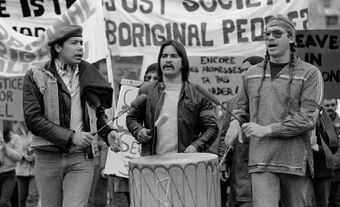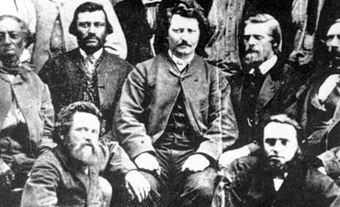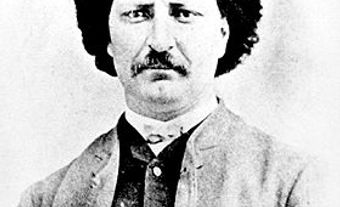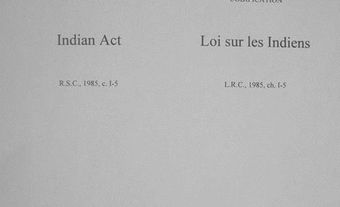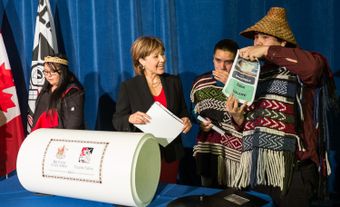The Kanesatake Resistance, also known as the Oka Crisis or the Mohawk Resistance at Kanesatake, was a 78-day standoff (11 July–26 September 1990) between Kanyen'kehà:ka (Mohawk) protesters, Quebec police, the RCMP and the Canadian Army. It took place in the community of Kanesatake, near the Town of Oka, on the north shore of Montreal. Related protests and violence occurred in the Kahnawake reserve, to the south of Montreal. The crisis was sparked by the proposed expansion of a golf course and the development of townhouses on disputed land in Kanesatake that included a Kanyen'kehà:ka burial ground. Tensions were high, particularly after the death of Corporal Marcel Lemay, a Sûreté du Québec police officer. Eventually, the army was called in and the protest ended. The golf course expansion was cancelled, and the land was purchased by the federal government. However, it did not establish the land as a reserve, and there has since been no organized transfer of the land to the Mohawks of Kanesatake.
This is the full-length entry about Kanesatake Resistance (Oka Crisis). For a plain-language summary, please see Kanesatake Resistance (Oka Crisis)(Plain-Language Summary).
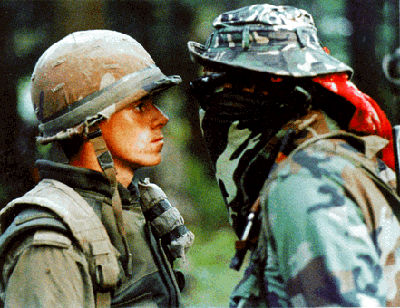
Historical Background
There was a long history behind the crisis at Oka. The Kanyen'kehà:ka (Mohawk) had been pressing for recognition of their right to the land since 1761. Almost immediately after Britain conquered New France, the Mohawks of Kanesatake wrote to government officials in Britain. They described living under unfavourable rules that threatened their livelihood. They contested their right to the land and asked to be freed from the authority of the Sulpicians, a Roman Catholic order that had been granted the land by King Louis XV in 1717. The Sulpicians had also begun selling the land to White settlers. The British ignored these demands.
The Kanyen'kehà:ka continued to contest their right to the land over the next 150 years; each attempt was rejected. In 1851, they petitioned Lord Elgin, governor general of Canada, asking him to recognize their right to the land. The request was denied. In 1859, the Province of Canada gave the Sulpicians official title to the land. In 1868, the government of the new Dominion of Canada denied that the Kanyen'kehà:ka original land grant reserved land specifically for them. The federal government later classified Kanesatake as an “interim land base” and not a reserve. It therefore was not covered under the Indian Act. ( See also Indigenous Land Claims.)

Mohawk group with William Workman, Mayor of Montreal, Kahnawake, QC, 1869.
The Mohawks of Kanesatake’s case over land rights was heard by the Quebec Superior Court in 1910; in 1912, it was heard by the Court of King’s Bench and finally by the Judicial Committee of the Privy Council — Canada’s highest appeals court at the time. The Judicial Committee ruled that official title to the land was held by the Sulpicians. By the end of the Second World War, the Sulpicians had sold all of their remaining land and had left the area. The Mohawks of Kanesatake were now confined to about 6 km2, compared to the 687 km2 they once held. However, ownership of the Kanyen'kehà:ka common area, known as “the Pines,” remained unresolved.
The Kanyen'kehà:ka of Kahnawake, Kanesetake and Akwesasne asserted Aboriginal title to their ancestral lands in 1975. But their land claim was rejected on the grounds that, since they did not hold the land continuously from time immemorial, their Aboriginal title was voided. The Kanesatake band filed a second land claim with the federal government in 1977. It was rejected in 1986, on the grounds that it did not meet the full legal criteria. (See also Kanesatake Resistance (Oka Crisis) Timeline.)
Golf Course Expansion
In 1961, a nine-hole golf course was built on the Pines. Despite the fact that the land came very close to a traditional Kanyen'kehà:ka (Mohawk) burial ground, the Kanyen'kehà:ka claim was rejected, and the golf course was built.
In 1989, the mayor of Oka, Jean Ouellette, announced a plan to build a townhouse complex and expand the golf course into the Pines and over the Kanesatake ancestral cemetery. Since the Kanesatake band’s land claim had been rejected in 1986, they were not consulted.
Despite months of protests by the Mohawks of Kanesatake, as well as concerns expressed by the Quebec Minister of the Environment and Minister of Native Affairs, construction was scheduled to begin in March 1990.

(©Robert J. Galbraith, courtesy Kanien’kehá:ka Onkwawén:na Raotitióhkwa Language and Cultural Center)
Blockade and Police Raid
To halt further development of the Pines, a group of people from Kanesatake constructed a barricade on a local road, blocking access to the area. Kanyen'kehà:ka (Mohawk) from two nearby reserves — Kahnawake and Akwesasne — along with a group of activists called the Mohawk Warrior Society, joined the protest, helping man the barricades.
After two injunctions to remove the roadblock were ignored, Oka town council asked the provincial police force, the Sûreté du Québec (SQ), to intervene. On the morning of 11 July 1990, the SQ advanced on the barricade. They used tear gas and concussion grenades to create confusion (although the gas blew back towards the police). During the brief gunfight that followed, SQ Corporal Marcel Lemay was killed. The SQ retreated. It was unclear who fired the first shot or who killed Lemay. (See also Kanesatake Resistance (Oka Crisis) Timeline.)

A Photojournalist joins several Mohawk people on a barricade in the Pines, summer 1990. (©Robert J. Galbraith, courtesy Kanien’kehá:ka Onkwawén:na Raotitióhkwa Language and Cultural Center)
Escalation
Resistance continued, with Indigenous supporters from the area and across the country joining the Kanyen'kehà:ka (Mohawk) warriors at the barricades. The SQ constructed their own blockades and checkpoints on roads leading to Oka and Kanesatake. Kanyen'kehà:ka from the nearby Kahnawake reserve blockaded the Mercier Bridge in support; this cut off access between Montreal’s southern suburbs and the Island of Montreal. The resulting chaos angered area residents. Relations between Indigenous and non-Indigenous people in the area worsened. The SQ had to deal not only with the barricades, but also with frustrated and hostile civilians. Many of them blamed the SQ for the situation. At the same time, the Kanyen'kehà:ka demands expanded to include full sovereignty.

A warrior raises his weapon as he stands on an overturned police vehicle blocking a highway at the Kanesatake reserve near Oka, Quebec, after a police assault to remove Mohawk barriers failed, 11 July 1990.
Federal Involvement
In mid-July, the RCMP was brought in to help the SQ. At the same time, Quebec Premier Robert Bourassa requested the help of the Canadian Armed Forces.
On 20 August, the armed forces’ Operation Salon began. Four thousand soldiers took up positions in and around Kanesatake and Kahnawake, along with armoured military vehicles, helicopters, artillery, police vessels on the Ottawa River, and other equipment. Members of the Royal 22e Regiment (the “Van Doos”) took over from the SQ at the Kahnawake and Kanesatake barricades. They assumed a position only metres from the Kanyen'kehà:ka (Mohawk) warriors. (For context, around 5,100 Canadian military personnel served in the Persian Gulf War, with a peak of about 2,700 in the region at one time. According to military historian Timothy C. Winegard, the armed forces’ operation at Oka was so extensive it used up their entire national stockpile of barbed wire.)

Some soldiers of the Canadian forces and two police officers of the Sûreté du Québec during the Oka crisis. At the rear, an AVGP Cougar (Armored Vehicle General Purpose). (courtesy Samuel Freli)
The Kanyen'kehà:ka were under heavy pressure. Increasing numbers of soldiers took positions at the Pines and elsewhere in the Montreal area. Reconnaissance aircraft circled above. By 29 August, negotiations had put an end to the blockade of the Mercier Bridge, though it would take eight days for the barricade to be dismantled and the bridge to reopen. On 1 September, with about 40 Kanyen'kehà:ka warriors remaining on the barricades, the Army advanced. The next day, soldiers dismantled the barricades.
The remaining warriors, as well as some women and children, took refuge in a residential treatment centre for drugs and alcohol on highway 344 across from the Pines, which had been used as a negotiation centre. They continued to negotiate but had little leverage. Their aim was to hold out until Parliament resumed on 24 September. (It had been on recess over the summer.) They hoped that their demands would be the focus of debate. (See also Kanesatake Resistance (Oka Crisis) Timeline.)

Mohawk warriors man the barricade on the Mercier Bridge, summer 1990. (©Robert J. Galbraith, courtesy Kanien’kehá:ka Onkwawén:na Raotitióhkwa Language and Cultural Center)
Tekakwitha Island Standoff
On 18 September 1990, SQ officers and army soldiers landed on Tekakwitha Island, on the outskirts of Kahnawake, and proceeded towards the community. At the bridge into the reserve, they were met by hundreds of Kanyen'kehà:ka (Mohawk). The soldiers attempted to lay razor wire, but it was dismantled by Kanyen'kehà:ka, who also threw rocks and assaulted the soldiers. The soldiers fired tear gas and warning shots, and assaulted Kanyen'kehà:ka with the butts of their rifles. After seven hours, the soldiers were airlifted out by eight Chinook helicopters. Twenty-two soldiers were injured, along with 75 Kanyen'kehà:ka, ranging in age from five to 72.

A Mohawk man winds up to punch a soldier during a confrontation on the Khanawake reserve on Montreal's south shore, 18 September 1990.
The Resistance Ends
The deployment of troops in both Oka and the Persian Gulf dominated the debate in Parliament when it resumed its fall session on 24 September. In the House of Commons the next day, Prime Minister Mulroney promised to meet some of the Kanyen'kehà:ka (Mohawk) unspecified demands.
The resistance ended on 26 September 1990. Thirty men, 16 women and six children suddenly left the centre; they surprised the army command, which had expected an orderly surrender. During the confusion, a soldier stabbed 14-year-old Waneek Horn-Miller in the chest with a bayonet. She had been carrying her four-year-old sister, Kaniehtiio, to safety after weeks behind the barriers while their mother, Kahentinetha Horn, served as a negotiator. The incident became front page news across the country.
Several warriors were detained by the military, and a number were later charged by the SQ. Five were convicted of crimes, including assault and theft; only one served time in jail.

Waneek Horn-Miller clutches her sister in one arm and a soldier's wrist in the other hand after being stabbed in the chest outside the Onen:to’ken Treatment Centre on highway 344, 1 September 1990.
Public Response
There was substantial media coverage of the resistance across the country and internationally. Public opinion on the matter varied widely. Many Quebecers, especially those living in the immediate area, were angered by the blockades. In one incident (captured in Alanis Obomsawin’s 2000 documentary Rocks at Whiskey Trench), local residents stoned about 75 cars containing mostly women, children and the elderly as they tried to leave the Kahnawake reserve. In another, 10,000 people marched through the nearby town of Châteauguay, demanding that the blockade of the Mercier Bridge be removed. Protesters hanged and burned an effigy of a Kanyen'kehà:ka (Mohawk) warrior. This continued for several nights in a row.
However, others sympathized with the protesters, including John Ciaccia, then Quebec Minister of Native Affairs, who repeatedly urged the Town of Oka to reverse course. Protests were also held across the country in support of the Kanyen'kehà:ka. In a show of solidarity, First Nations across Canada organized protests or erected blockades, including several in British Columbia that blocked roads and railways. The Canadian Pacific Railway’s John Cox told media at the time: “Virtually all our transcontinental traffic has been disrupted. We are at the mercy of individual bands and whatever decisions they make.”

Royal Commission on Aboriginal Peoples
The Kanesatake Resistance played an important role in the creation of the Royal Commission on Aboriginal Peoples. It was established by Prime Minister Mulroney on 26 August 1991 to investigate questions about Indian Status and other issues that the resistance brought to the fore.
The Commission released its report in 1996. The main conclusion was the need for a complete restructuring of the relationship between Indigenous and non-Indigenous peoples in Canada. Some of the broader recommendations included a proposal for a new Royal Proclamation. This would require the government to commit to a new set of ethical principles respecting the relationship between Indigenous peoples and the state. This new relationship would acknowledge and respect Indigenous cultures and values, the historical origins of Indigenous nationhood and the inherent right to Indigenous self-determination. (See Indigenous Self-Government in Canada.)
Implementing many of the recommendations in the Royal Commission would require constitutional change. Most of the recommendations were not implemented.

Aftermath
During the crisis, the federal government agreed to purchase the Pines to prevent further development. The golf course expansion and townhouse construction were cancelled. After the crisis had ended, the government purchased additional plots of land for Kanesatake. In 2001, the Kanesatake Interim Land Base Governance Act confirmed that the land was to be reserved for the Mohawks of Kanesatake. However, it did not establish the land as a reserve, and there has since been no organized transfer of the land.
Investigations conducted after the crisis revealed several problems in the SQ’s handling of the situation, including command failures and prejudice among SQ members. The only official, full-scale hearing into the event was the coroner’s inquiry into Corporal Lemay’s death. It has never been determined who fired the shot that killed him.
Significance
The Kanesatake Resistance, also known as the Oka Crisis, played an important role in the creation of the Royal Commission on Aboriginal Peoples. This in turn contributed to new agreements between governments and Indigenous peoples, including the Paix des Braves (Peace of the Braves) between the Grand Council of the Crees and the Quebec government. Since the resistance, federal and provincial governments have developed greater awareness of the territorial rights of First Nations and the need to consult Indigenous peoples when considering development projects. (See Duty to Consult.) Overall, the crisis made more Canadians aware of Indigenous rights and land claims; it also illustrated the potential for future conflict if such claims were not resolved in a timely, transparent and just manner.
The Kanesatake Resistance inspired Indigenous peoples across Canada to take action. For example, the resistance has been linked to the Idle No More movement, as well as demands for an inquiry into missing and murdered Indigenous women and girls in Canada. Some experts suggest that the resistance had an impact outside Canada as well. According to University of Ottawa professor Marcelo Saavedra-Vargas, Oka was an “awakening” that has inspired indigenous movements elsewhere, such as in Bolivia.
See also Indigenous Land Claims; Aboriginal Title; Indian Act; Rights of Indigenous Peoples in Canada; Indigenous Self-Government in Canada.

 Share on Facebook
Share on Facebook Share on X
Share on X Share by Email
Share by Email Share on Google Classroom
Share on Google Classroom
